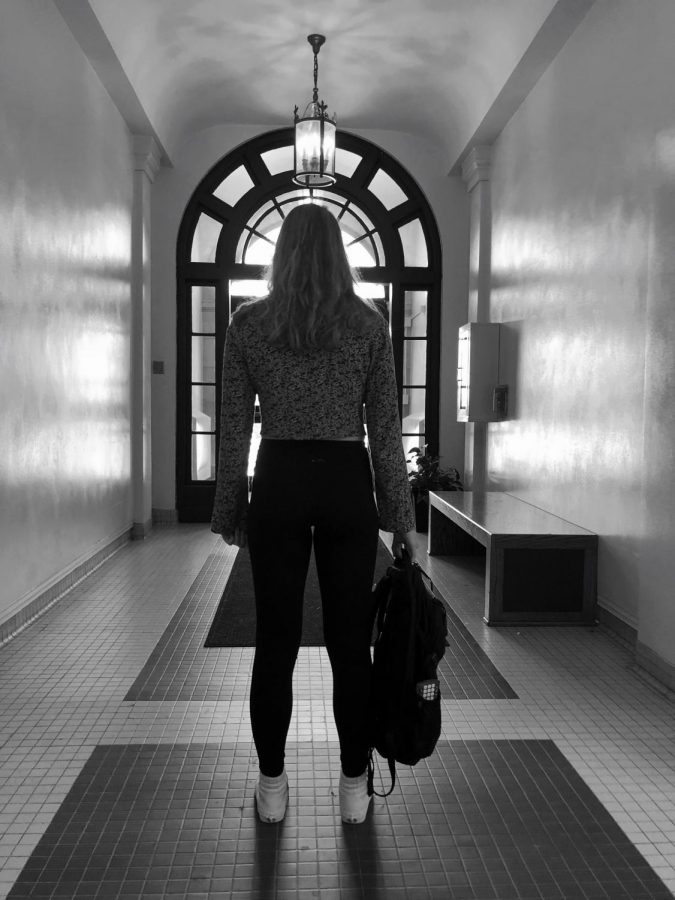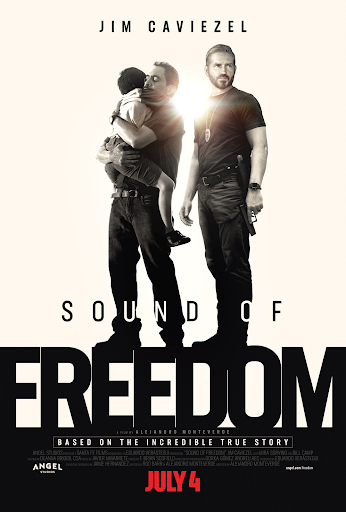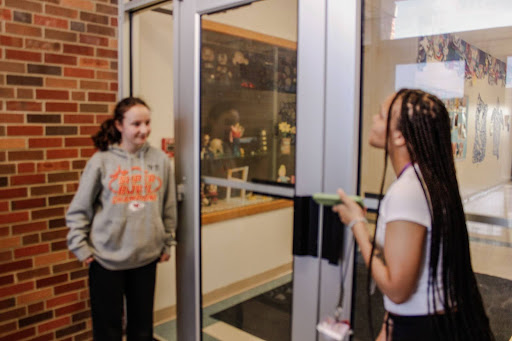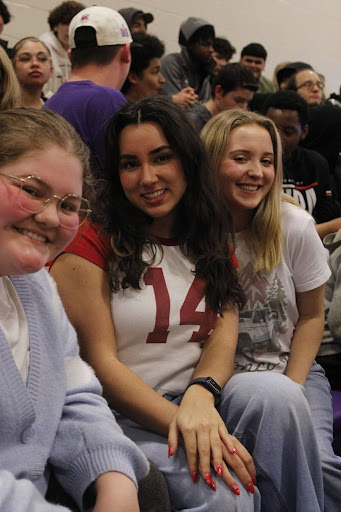School Hardening
You stand on the steps of the North Entrance, waiting to be buzzed in. You hear the door click and pull it open, making sure not to let anyone in behind you. You walk through North Office and into the hall, making your way up the stairs into your first class. The music plays and the bell rings. Your day has finally begun. Shortly after, an announcement plays over the intercom. There is an intruder in the school on your side of the building. You and your classmates quickly move to turn off the lights, lock and barricade the door, and hide out of sight. As the intruder moves to the other side of the building, your teacher instructs your class to quietly run out of the building and into the lawn. You know if this were a real situation, you’d go much further.The likelihood of this being a real situation seems to grow greater by the day, as our news is filled with more and more stories of mass shootings. Mere weeks before we started school this year, our country was rocked by two mass shootings in the span of 13 hours. The first in El Paso, Texas, outside a Walmart, which left 22 people dead and 26 others injured. The second in Dayton, Ohio, which killed 9 people and injured 27 in less than 30 seconds. In the United States, there are 100 firearm-related deaths each day and hundreds more are injured, according to Everytown for Gun Safety. Additionally, recent data suggests that gun-violence is the second leading cause of death for children and teens. And while the vast majority of these deaths take place outside of schools, the high-profile school shootings our country has seen over the past twenty years have called our nation’s school security practices into question.
TARGET HARDENING
In 1999, 13 people were shot to death in Columbine High School in Columbine, Colorado, an event that rocked the nation and created the “Columbine generation,” a generation of children who have grown up accepting school shootings as a reality of life and a very real threat.
Our own state of Missouri has seen 36 school shootings since 1970. In 2018, Marjory Stoneman Douglas High School in Parkland, FL, was the scene of a shooting which took the lives of 17 people, becoming the largest school shooting since Sandy Hook five years previously. It was these most recent shootings that have resulted in renewed calls by students, teachers, and parents across the country for greater school safety. One approach to this has been the “target hardening” of schools. Secure Community Network, a non-profit specializing in security efforts, defines target hardening as “a process wherein a building is made into a more difficult or less attractive target.” In popular media, the term has become suggestive of arming teachers, bulletproof windows, clear backpacks, school resource officers, and metal detectors, all in an effort to deterrence of gun violence specifically.
AT OUR FRONT DOOR
Target hardening has even reached Columbia. As of the 2019-2020 school year, new security measures have been put in place at the high schools to protect students from dangers. At both Hickman and Rockbridge, door monitors have been hired and the number of available entrances during the school day has been significantly reduced as the district moves to what John White, Security Coordinator of CPS, calls “secured vestibule and single points of entry.” This school year, everyone is required to enter through the North Entrance after the clock hits 8:55. They then must go through a multi-step process to leave the office. Soon, the entrance will be blocked off from the main hallway by a wall of bulletproof glass. It’s quite a change from easily coming and going from the west side of the school in years past. “When I started over 8 years ago we didn’t lock a single outside door for any of our buildings,” White said. “No one would think that this is a good idea in today’s climate. So [CPS has] made changes to keep up with the times.”
Although a bit of an inconvenience for students and staff, it has an important purpose. “Now you have one point of entry so you know where kids should and should not be leaving the building from,” Coach Wilson, one of the entry monitors says, “It really helps with monitoring things.” One measure that CPS has chosen not to take is the implementation of metal detectors, and the data shows this is probably for the best. Although they are highly effective in preventing the entry of weapons into the school, some research suggests that treating students like prisoners actually incites violence and acts as a prison pipeline. A study by the ACLU found that schools with metal detectors issued more suspensions than comparable schools without metal detectors.
THIS IS JUST A DRILL
Another safety precaution in place at Hickman, and one that has been implemented in virtually every high school across the country in the last few years, are intruder drills. “We are required to have an intruder drill within first two weeks of school,” said athletic director and head of safety and security for Hickman J.D. Coffman. “I work that out with the district security and safety office and they approve the dates.” The first intruder drill of the year is a no-evacuation drill. This is where teachers are expected to talk to the students about what you should expect out of a drill and how you should react. There is another one in the first semester and one in second semester. These are the three drills required throughout the year by the district. The next two are active intruder drills. “A safety and security person, such as Melvin Buckner, the head of safety and security for CPS, or Officer Dutton will follow the intruder around through the halls and usually what we do is make it as realistic as possible by going on computers to track them so we can announce their location over the intercom,” said Coffman. Coffman states that the purpose of the drills is to practice and have practical application so that students are more prepared if there were to be an actual intruder. “If there is an intruder there’s going to be some panic but hopefully the instincts will kick in and you will remember what to do and follow the directions of teachers and the intercom,” said Coffman. “Hopefully having practice reduces the amount of stress for kids and students so they react appropriately so we can keep as many people as safe as we can.”
Coffman believes the intruder drills are effective at Hickman.“I’m not for sure, but I feel like students do take it seriously because of the violence in the news. Kids are aware of it and they are concerned about it. So I think they do take it more seriously than other types of drills.”
CANDID CAMERA
Additionally, many schools are taking to security cameras and social media monitoring to track student behavior in an effort to get ahead of a potential threat. But, keeping track of how students spend their time online and on social media has become an issue of the right to privacy. Many believe that this is violating students’ privacy and the school should leave the job to law enforcement. However, others argue that it is far more important to know when students are making dangerous statements on the internet or posting harmful information. As of now, monitoring students’ online activity takes place at a higher level in Columbia Public Schools. The School Board office is in charge of monitoring student’s online activity, but there are also many organizations that watch everyone’s social media, including students themselves. At Hickman alone, Mr. McCarthy says that students bring in documents or printed screenshots of texts, direct messages, or posts two to three times a week as proof for a conflict. Additionally, Hickman admin have the ability to go back and review altercations on school property that have been captured on one of Hickman’s 90 security cameras. The use of high-tech to monitor students has become much more popular, with the percent of schools with security cameras rising from 19.4% to over 80 percent in less than 20 years according to the National Center for Educational Statistics. Despite its recent popularity, some data suggests that school hardening may not be a good solution to the gun violence epidemic. A new study out of Ohio State University finds that students and staff in schools that employ hi-tech security measures experience higher levels of fear.
ON DUTY
Another significant component of school target hardening is the employment of school resource officers (SROs): policemen who stay in schools and handle severe altercations. At Hickman, we have both an SRO and off-duty patrollers during lunch hours.The consequences of having police officers in a school has been met with many mixed feelings. An article by The Rolling Stone noted having school resource officers in school means, “a child’s minor misbehavior or perceived disrespect can quickly escalate or lead to an arrest, criminal summons or suspension.” However, Hickman’s SRO, Officer Sean Dutton, is a father to two Hickman students and has a more optimistic view of his role in the school. “When people hear about a cop in the school they immediately attribute it to a bad thing, but we like to think about it as a relationship-building,” Dutton said. “I get to go into classrooms and teach classes. So that gives me an opportunity to engage and interact with students than just the cop coming in and making an arrest…The kids know me, trust me, I’m fair, consistent, and honest with them, it’s not just ‘Officer Dutton is coming in to cause problems and arrest people, it’s Officer Dutton is coming to help.’”
Dutton doesn’t believe having an SRO in school truly escalates situations. “Are there cops that can sometimes escalate situations? Absolutely. But there are people in every profession in the world there are good people in that profession and bad people in that profession. For the people that say verbatim every time a cop escalates a situation I highly disagree with that because I pride myself in trying to de-escalate situations”
Despite this, Officer Dutton understands that many people have a negative view of law enforcement which he accepts as something his positive interactions won’t change. However, he doesn’t let this discourage him. “I think schools are kind of the microcosm of our society as a whole. So what I mean by that is a very small percentage, no matter what we do as law enforcement, they’re not going to like us, we’re going to be wrong all the time. But that’s a very small percentage and I think that’s the same in school. I think if you ask most people in the school, and if they were honest, they would say that it’s probably a good thing that we are here.”
In some districts, SROs are heavily involved with issuing suspensions and minor disciplinary actions within the school, which is often related in the media as the phrase “school-to-prison pipeline.” At Hickman, this is not the case. Officer Dutton is only involved if a law has been broken and the school decides his assistance is needed based on the contract he has with the school. “As far as inside the schools, our hope in the law enforcement community is that by us being here its a positive thing,” Dutton said. “And again, it’s not us trying to catch students doing wrong, trying to be integrated into the community and being involved, so one, you guys can see me as a person and that you guys know that we are playing on the same field here.” Hickman Junior, Chase Ashton, believes that school “Hardening is definitely the way to go.” In fact, Ashton believes intensifying school safety more may be wise.“I think we should be cracking down because recently there have been a lot more school shootings and that’s never good.” However, he worries about the pressure being put on our one SRO. “We have Officer Dutton but that’s just one guy, he’s not going to be around the school the whole time so maybe just more police officers or something like that.”
GOOD GUY WITH A GUN?
What to do when an SRO or police officer can not alone cover a large school has led some to call for arming teachers, a highly controversial topic that is often simplified with the phrase “good guy with a gun.” In Missouri, House Bill 575, which would allow concealed carry in private K-12 schools and college campuses, and the arming of teachers on college campuses, passed out of a Senate committee in April of 2019. The bill is expected to be voted on by the Missouri Senate when the legislative session convenes in January. Arming teachers is posed as an addition to SROs and also as a substitute in districts that may not have the funds to hire an SRO. In a poll conducted at Hickman, 89.7% of staff said they’d be uncomfortable knowing a staff member other than an SRO was armed. “My degree is in teaching, not shooting,” said Mrs. Jalen McGregor. Other teachers were worried about the negative tone set in the classroom by teachers being armed. A staff member who preferred to remain anonymous noted: “It would create a culture of fear.” Another staff member, Mrs. Noelle Gilzow said “ I don’t believe being a potential threat is a good way to form relationships with my colleagues or students.” And it is not just Hickman teachers that feel this way, Ashton agrees with them, “I don’t agree with arming teachers just because that’s not their job, they’re just here to teach the kids. I just don’t think it’s safe to have a gun in the classroom where some kid could get it and that’s just not a good situation to be in.”
POLICY OVER PROCEDURE
It’s hard to measure statistical significance for security increases, especially when school shootings are incredibly rare, comprising less than one percent of all gun violence across the nation according to Everytown Research. However, the existing data shows some measures are not always effective. Although school hardening measures have dramatically increased since the Columbine shooting in 1999, gun violence in schools continues to be on the rise. According to the Center for Homeland Defense and Security, 2018 was the worst year on record for school shooting with its 97 incidents surpassing the previous record of 59 incidents in 2006. One Hickman student, junior Jordan Narrol, believes this is because these measures are only treating a symptom of a larger problem. “It’s like having a hole in an airplane and trying to fix it with duct tape. You’re not fixing the core problem and it can easily still be exploited.” And there are many across the country that agree with him. Rather than harden schools, some propose stricter legislation on firearms as the solution to the gun violence epidemic. This can also include gun violence prevention programs such as the Be SMART program by Moms Demand Action, which educates families on safe storage of firearms and keeps dangerous weapons out of the hands of children. Laws and programs focused at an individual’s home life are important because 80% of the firearms used in school shootings come from the perpetrator’s home or friends, according to Everytown for Gun Safety. This was true for the perpetrator of the Santa Fe High School shooting. Narrol agrees, “In my opinion, the core of the problem is the fact that pretty much anyone in this country can get military-style assault weapons and then go shoot up a school,” he said. “That shouldn’t be possible… and it’s why America has all of these mass shootings and no other country does.” Schools, however, cannot influence policymaking, and therefore don’t have many options when it comes to protecting their students. However, Narrol believes there are things schools could do to help their students push for change.“ One thing I think the schools could do is increase the ability of the students to pressure those politicians and increase what they allow with protests and other such things on school grounds.”
One option along these lines that is available to schools is focused work on improving school safety is changing the “school climate.” Creating a school environment that is welcoming for students both emotionally and socially is important in reducing violence. Making sure students are getting the emotional care they need is important, especially since 12% of gunfire on school grounds is related to suicide, whether that be successful or attempted according to Everytown Research. This includes improving student-staff relationships, making sure students feel comfortable talking to their teachers and other staff members, not only about their own emotions but about things they are noticing in others. The Department of Homeland Security has a program called See Something, Say Something®️ which “engages the public in protecting our homeland through awareness-building, partnerships, and other outreach.” This program is used in facilities across the nation, including Hickman. This is because in 51% of mass shootings, warning signs were present before the event according to Everytown Research. For many, this is grounds to pass Red Flag Laws, or Extreme Risk Protection Orders, legislation which temporarily remove guns from homes whose inhabitants pose a risk to themselves or others.
BALANCING ACT
The topic of school hardening is controversial for many reasons. In the end, every decision becomes a question of keeping schools safe without compromising the nature of a school. “I think that hardening of schools is a balancing test,” White said. “We want to make sure we are the safest that we can be but we have to balance that with not turning our schools into something that looks and feels like a prison.”
——
For example, a school resource officer was on duty when the Parkland shooting occurred and took a defensive stance outside of the school for the entirety of the shooting. Additionally, it has been proven that schools with SROs often issue more suspensions, expulsions and arrests which funnel kids into the criminal justice system. This is especially true in schools attended predominantly by students of color.
After the Parkland shooting, many of the survivors created the March for Our Lives movement, which is specifically focused on preventing gun violence in schools. This movement garnered support from millions across the nation, especially children. While many of his classmates pushed for stronger gun-sense legislation, Kyle Kashuv, a Parkland survivor, had a different opinion about school safety. Through online posts, interviews, and conference speeches, he has pushed for greater school safety through stricter background checks and psychiatric evaluations. He most drastically veers from his peers when it comes to the subject of banning firearms, and is frequently quoted as saying: “it’s people that are the issue, not guns.”
BACKPACKS (CLEAR OR BULLETPROOF)
Bulletproof backpack sales increased by 200% after the first week of August when three deadly mass shootings took place across the country according to CNN. Bulletproof backpacks are simply regular bags with ballistic panels sewn into the back, which many people say is not nearly enough to stop a bullet. Some parents believe that buying their child a bulletproof backpack will cause more harm than anything, causing them to panic or stress. Another argument against bulletproof backpacks is the steep prices. Most brands can range anywhere from $160 to $500 with some tests even showing they don’t protect from higher caliber rounds. Not many families can afford such an expensive backpack, which begs the question whether or not wealthier families should have better protection for their children.
Another policy enforced by certain schools is the requirement of clear or mesh backpacks. Heaps of schools that have issues with gang violence or past shootings have their students wear only clear backpacks. The idea is to make it more difficult for kids to bring guns to school, but the same issue of privacy is a concern. Many are worried having clear backpacks can expose students to scrutiny, especially for those who use menstrual products and may be embarrassed by having then on display. Parents also worry about the durability of the backpacks, as it is difficult to find a clear or mesh backpack that would protect a laptop or other devices.
A clear backpack policy was enforced at Marjory Stoneman Douglas High School after the tragic Parkland Shooting. The students and survivors of MSD fought back by openly mocking their clear backpacks by putting menstrual products, condoms, and print-out memes in the front pocket for everyone to see.






